10 Digital Marketing Trends You Should Know About in 2025

Digital marketing moves fast. What worked last year might be useless today. Platforms change, algorithms shift, and new tools pop up overnight. If you’re not keeping up, you’re falling behind.
Staying updated isn’t about chasing every new trend. It’s about knowing what actually works and adjusting your strategy before everyone else catches on. The marketers who adapt early get the biggest rewards. The ones who ignore change? They get left behind.
The way people buy online is changing. Privacy concerns, AI, and shifting consumer behavior are rewriting the rules. Marketers can’t rely on outdated tactics anymore.
The future is about smarter strategies, better personalization, and meeting customers where they are without being annoying.
Some trends will make things easier. Automation and AI can handle the boring stuff. Other changes like stricter privacy laws, will force businesses to rethink how they collect and use data.
The key is to pay attention to what’s coming, test what works for your brand, and don’t get stuck in the past.
Key Takeaways
- Digital marketing is critical for increasing brand visibility and customer engagement.
- Implementing best practices can significantly enhance your digital marketing ROI.
- Email marketing continues to be one of the most effective tools available.
- Staying informed about trends is crucial for adapting strategies over time.
- Utilizing analytics can help track and optimize marketing campaigns efficiently.
- Mobile marketing is more important now than ever due to changing consumer behaviors.
What is Digital Marketing?
Digital marketing is just marketing, but online. Instead of billboards and flyers, you use websites, social media, email, and ads.
It’s how businesses get attention, build trust, and sell products. The goal is to get the right message to the right people at the right time.
For example, have you ever clicked on an Instagram ad? Got an email from a brand you like? Googled something and found a blog that answered your question? That’s digital marketing in action.
It’s not just about selling. It’s about showing up where people are already looking. Do that well, and you don’t chase customers—they come to you.
Digital Marketing Trends You Should Know About
Digital marketing never stays the same, and staying ahead can make a real difference. Some trends come and go, but others redefine how businesses connect with people. Here are 10 key trends shaping the future of digital marketing.
1. AI-Powered Marketing: The Future Is Here

AI isn’t just a trend. It’s rewriting how we market. HubSpot’s State of Marketing Report 2024 says 64% of marketers use AI and automation. Gartner predicts that by 2026, 80% of marketing roles will use GenAI. Also, 30% of workers already use AI for data analysis, a Work Innovation Lab Report found.
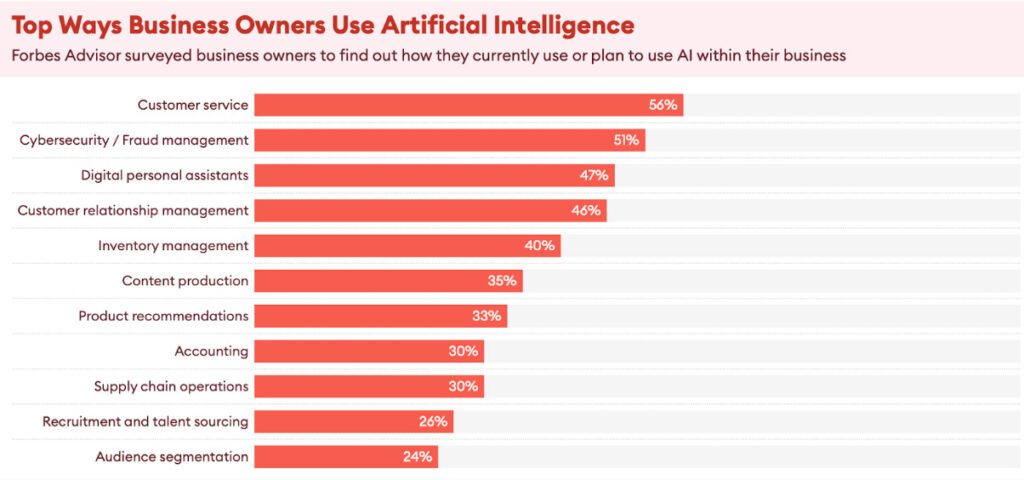
AI is everywhere—writing content, running chatbots, and predicting what customers will do next. Brands are using AI to create blog posts, emails, and social media updates in seconds. It’s fast, but let’s be honest—AI-generated content can feel a little… lifeless. That’s why smart marketers use AI to assist, not replace, human creativity.
Then there’s AI in customer service. Chatbots answer questions 24/7, handling simple stuff so businesses don’t need a full-time support team. Some are so advanced that they mimic human conversations. Others? Let’s just say you know when you’re talking to a bot.
AI also helps with personalization. It tracks user behavior, then tailors emails, ads, and recommendations. Ever wonder how Amazon knows what you want before you do? That’s AI analyzing your clicks and searches. When done right, it feels helpful. When overdone, it’s creepy.
But here’s the problem—too much AI can make marketing feel cold. Nobody wants to talk to a robot all the time. That’s where balance comes in. Use AI for efficiency, but keep the human touch. People trust people, not machines.
And then there’s the ethical side. AI collects mountains of data. The question is—how much is too much? Users want personalization, but they don’t want to feel like they’re being watched. Transparency matters.
Always remember AI is a tool, not a replacement for a real connection. Use it to work smarter, but don’t lose the human element.
2. Voice Search & Conversational AI

People are talking to their devices more than ever. Voice search is a real shift—it’s changing how we find information. Instead of typing “best running shoes,” people say, “What are the best running shoes for long-distance?” See the difference? It’s natural, longer, and more like how we actually speak.
According to DataReportal, 30% of internet users aged 16-64 worldwide use voice assistants each week.
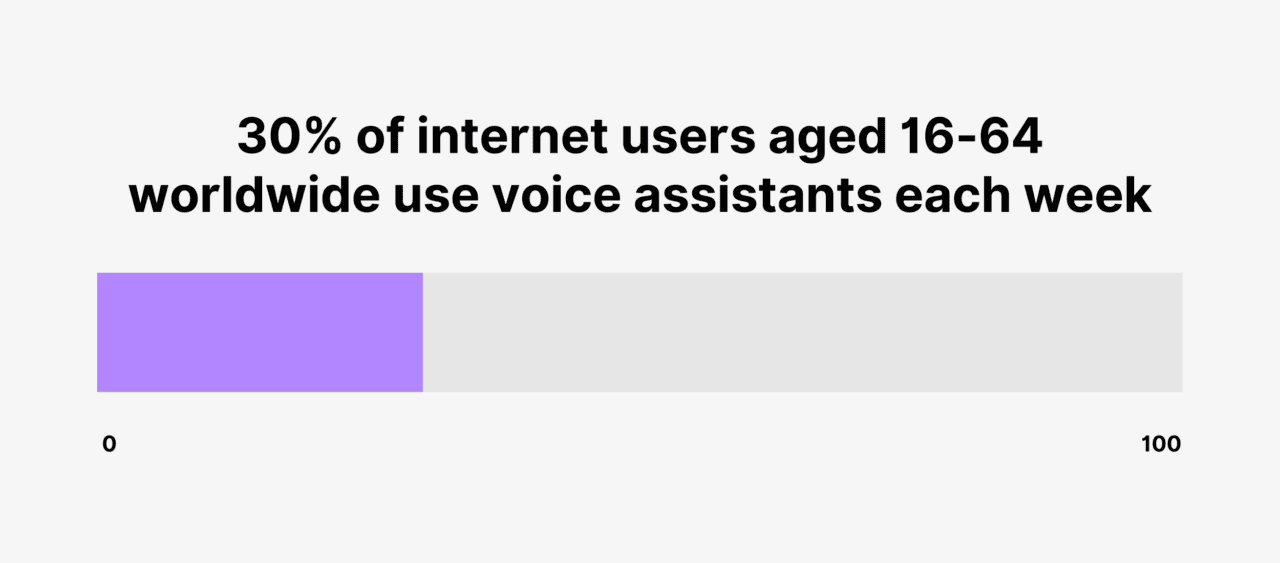
Here are other important voice search statistics:
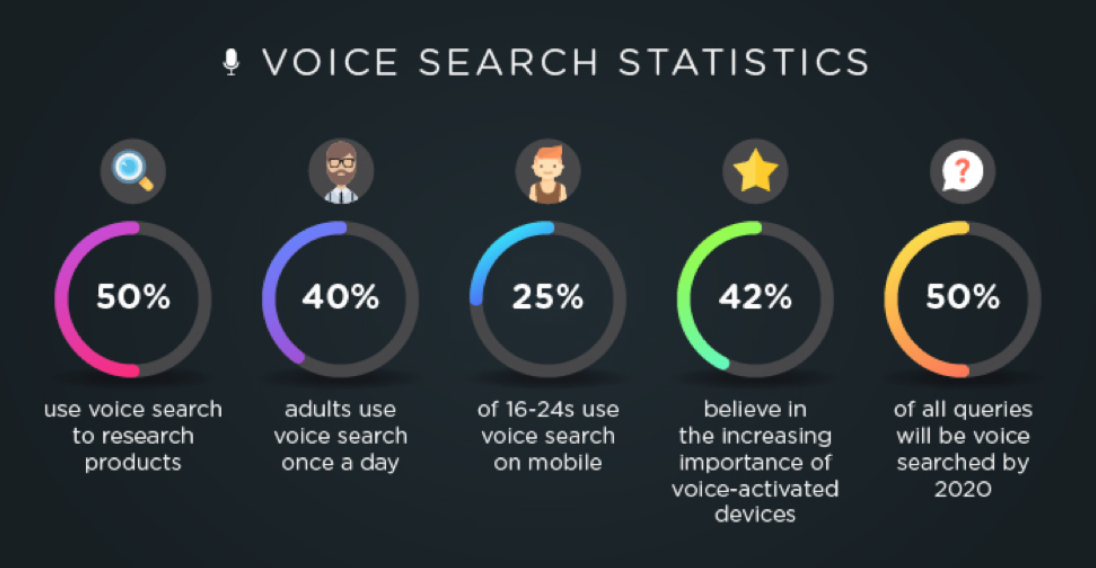
This shift means SEO goes beyond keywords now. You need to optimize for real conversations. Think about what your audience would ask if they were talking to a friend.
Use natural, full sentences in your content. Answer common questions directly. If your site doesn’t sound human, voice search won’t pick it up.
AI tools like Siri, Alexa, and Google Assistant are becoming digital middlemen. They don’t just pull up a list of search results—they give a single answer. If your content isn’t optimized for this, you won’t even be in the conversation.
So, how do you stay ahead of the game? Write the way people talk. Use question-based headings. Add clear, direct answers. Structure content so AI assistants can grab quick, relevant responses. If your content sounds stiff or robotic, you’re losing traffic.
Voice search is only growing. If you don’t adjust, your rankings will drop. Simple as that.
3. The Dominance of Short-Form Video
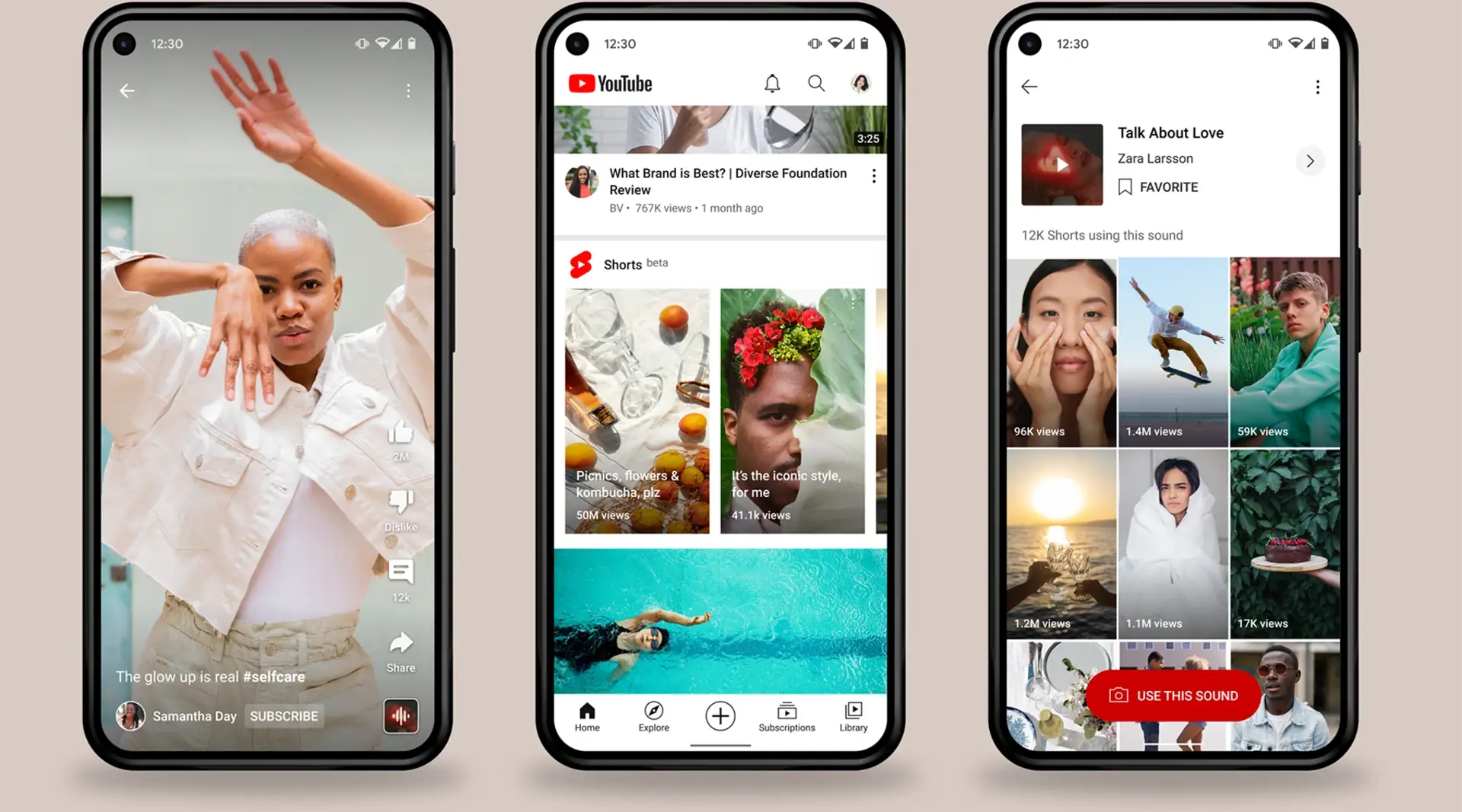
Short videos are gaining attention and becoming the standard. TikTok, Instagram Reels, and YouTube Shorts serve as more than just entertainment hubs. They’re shaping how people consume content, shop, and engage with brands.
People don’t want long, polished ads anymore. They want quick, engaging clips that feel real. A well-timed trend, a relatable story, or even a raw, behind-the-scenes moment can do more for a brand than a million-dollar campaign.
Studies show that 73% of consumers prefer short-form videos when learning about a product or service. That’s a clear signal—attention spans are shorter, and brands need to adapt.
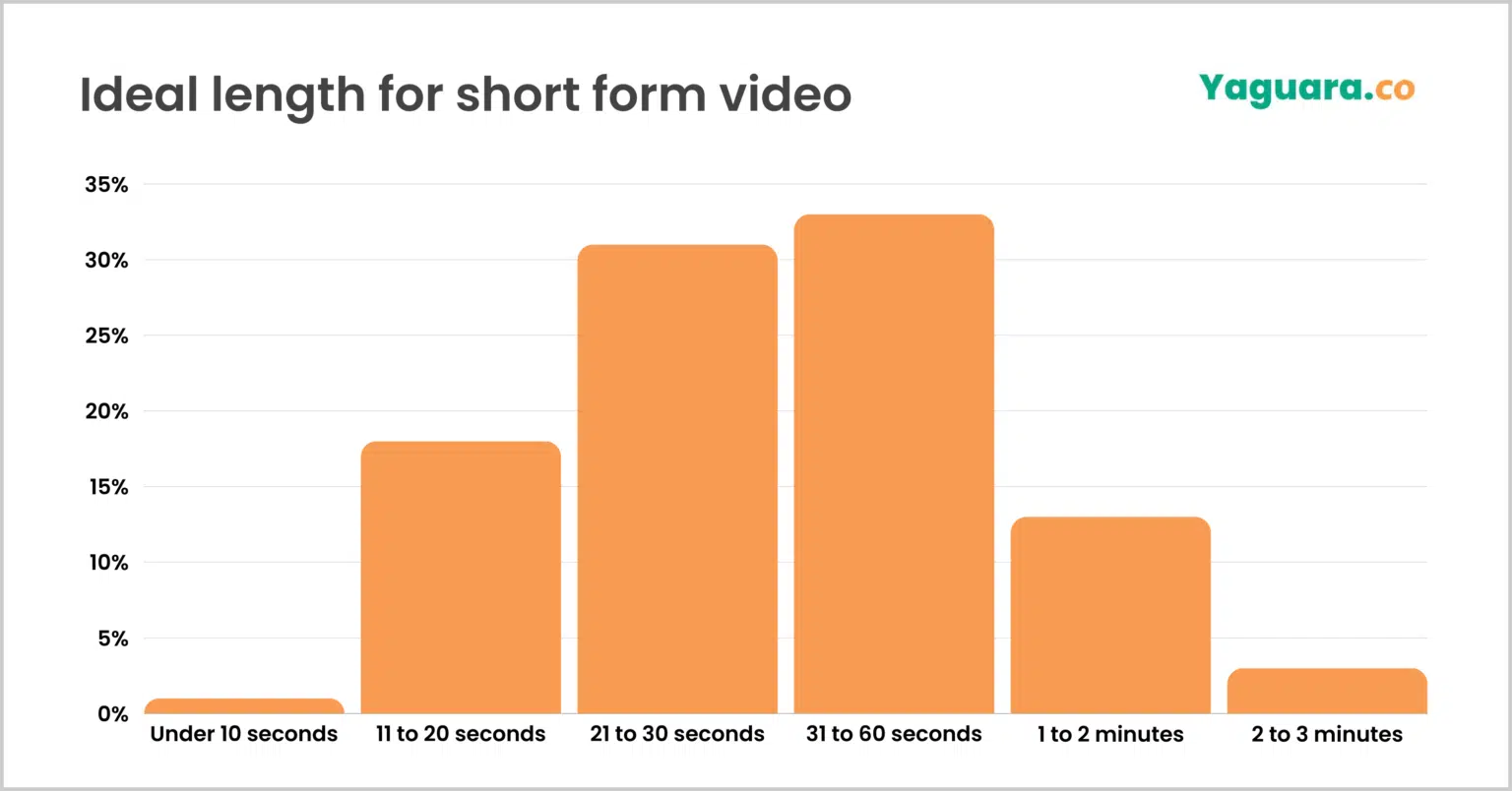
Brands that succeed with short-form video do more than just post. They’re part of the conversation. They jump on trends, create challenges, and go live. The main aim is to keep it natural. The less it feels like an ad, the better it works.
Live video is another big opportunity. It builds trust fast. Whether it’s answering questions, showing a product in action, or just chatting, live content makes brands feel human. People want that. And with 82% of viewers saying they prefer a brand’s live video over social posts, it’s an opportunity brands can’t ignore.
Short-form video isn’t going anywhere. If anything, it’s only getting bigger. Adapt or get left behind.
4. The Rise of User-Generated Content (UGC)
Consumers trust other people more than brands. That’s why user-generated content (UGC) is everywhere. It’s the reviews, testimonials, and organic posts that people share about a product or service.
Unlike traditional ads, UGC feels real. It’s raw, unpolished, and straight from the customer’s experience.
Why Consumers Trust UGC Over Traditional Ads
People know ads are scripted to sell. UGC, on the other hand, comes from real buyers. Studies show that 79% of people say UGC influences their buying decisions more than brand ads. This indicates that people trust other customers’ experiences when deciding what to buy.
Another report by Nielsen found that 92% of consumers trust recommendations from peers over company messaging. The numbers don’t lie—UGC builds trust.
How to Encourage UGC for Brand Credibility
Brands can’t just sit back and hope for UGC. They need to create a reason for people to share. Here are a few ways to make it happen:
- Ask for it. A simple “Share your experience!” goes a long way.
- Make it fun. Contests, challenges, and hashtags get people excited to post.
- Feature real customers. When brands showcase user content, it encourages more people to join in.
- Offer incentives. Discounts or exclusive perks in exchange for reviews or social media posts work wonders.
The key here is to let customers tell the story. Forced UGC looks fake and kills trust.
UGC-Driven Campaigns That Worked
Some brands have mastered UGC and turned it into massive wins.
- Coca-Cola’s “Share a Coke” Campaign
People loved seeing their names on Coke bottles. They took photos, shared them online, and made the campaign a viral success. Sales jumped by over 2%, which is huge for a brand of that size. - GoPro’s Customer Footage Strategy
GoPro barely makes its own ads. Instead, it highlights videos from real users. This strategy has built a community of content creators who showcase GoPro’s products better than any traditional ad ever could. - Glossier’s Community-Driven Growth
Instead of big-budget ads, Glossier relied on real customer testimonials and Instagram posts. The result? A cult-like following and over $100 million in annual revenue.
UGC is shaping the future of marketing. People trust people. Brands that get this will stay ahead.
5. Hyper-Personalization & First-Party Data
Personalization used to mean adding a first name to an email. Not anymore. Today, brands use real-time data to predict what customers want before they even ask. That’s hyper-personalization. It’s shaping how businesses connect with people in a way that feels natural.
Moving Away from Third-Party Cookies
For years, brands relied on third-party cookies to track users and serve targeted ads. That’s changing fast. Google is phasing out cookies, and privacy laws are tightening. Businesses that depended on third-party tracking now need new solutions.
The answer? First-party data—information collected directly from customers. Website activity, purchase history, and survey responses all provide valuable insights. Brands that own their data stay in control and build stronger customer relationships.
AI’s Role in Personalization
AI is making personalization smarter. It analyzes customer behavior in real time and delivers content people actually care about. Here’s how businesses are using it:
- Dynamic Websites: Homepages adjust based on what a user has browsed before.
- Smart Product Recommendations: AI suggests items based on past purchases, not random guesses.
- Automated Customer Service: Chatbots improve responses by learning from previous interactions.
AI helps brands create smoother, more relevant experiences. Instead of blasting generic ads, companies can tailor their messages in ways that feel natural.
Ethical & Transparent Data Collection
People don’t mind sharing data—if they trust the company collecting it. The problem? Too many brands have abused that trust. Now, transparency is key.
What works:
- Clear Opt-Ins: Let people know what they’re signing up for. No fine print tricks.
- Value Exchange: Offer something in return, like exclusive content or discounts.
- Easy Opt-Outs: If someone wants out, make it simple.
Hyper-personalization only works when customers feel in control. Businesses that respect privacy while offering real value will earn lasting loyalty.
6. SEO in the Era of AI & Google’s SGE
Search is changing. Google’s AI-powered Search Generative Experience (SGE), A.K.A AI overview, is shaking up rankings. Instead of just links, Google now gives AI-generated answers right at the top. That means fewer clicks on websites. If your content isn’t built for AI-driven search, you’re already behind.
How Google’s SGE Is Changing Rankings
SGE, now rebranded as AI Overview, pulls information from multiple sources to deliver a summarized answer. Users get what they need without visiting a site. That’s a big shift, and traditional SEO tricks won’t cut it anymore. Adaptation is key.
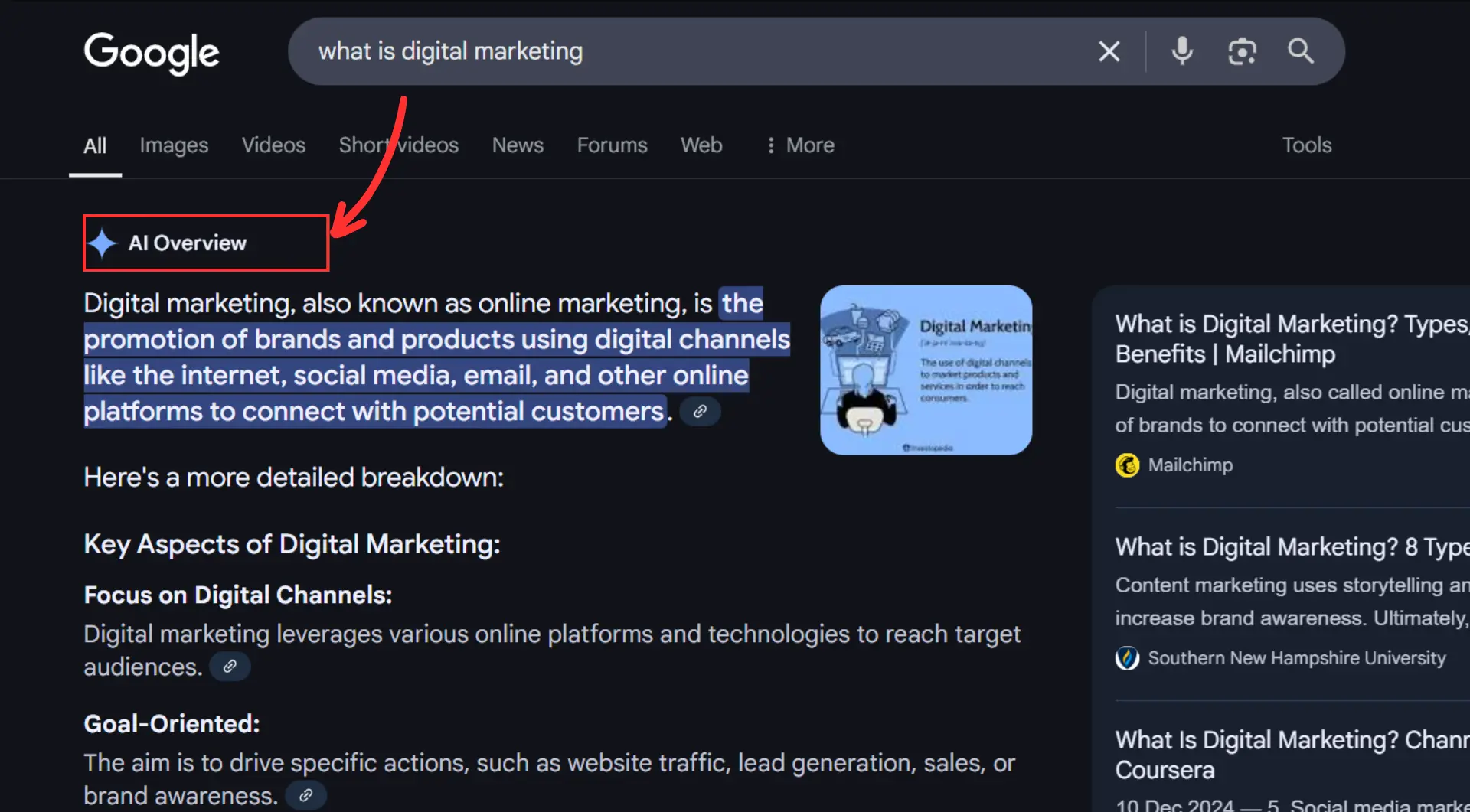
Google still relies on quality content, but now context matters more than ever. It’s not just about keywords—it’s about answering questions better than anyone else. Content needs to be in-depth, well-structured, and easy for AI to process.
The Role of E-E-A-T (Experience, Expertise, Authority, Trustworthiness)
Google wants content from real experts. That’s where E-E-A-T comes in. The more credibility you have, the better your chances of ranking.
Here’s what matters:
- Experience: Have you actually used the product or service you’re talking about?
- Expertise: Do you know what you’re talking about, or are you just guessing?
- Authority: Are other trusted sites linking to you?
- Trustworthiness: Is your content accurate and honest?
Google favors real voices over generic content. If you’re just rewording what’s already out there, you won’t rank.
Adapting Content Strategies for AI-Generated Search Results
SEO today is about giving AI what it needs while still engaging real people.
Here’s how to stay ahead:
- Focus on Answers: AI scans content for direct, clear responses. Make sure yours is easy to find.
- Use Structured Data: Schema markup helps Google understand your content.
- Write Like a Human: AI pulls from natural, well-written content. Over-optimized junk won’t work.
- Build Authority: Get backlinks, real reviews, and user-generated content to prove credibility.
Search engines aren’t just listing links anymore. They’re curating knowledge. If your content doesn’t stand out, it won’t be seen.
7. Social Commerce & Shoppable Content
Buying online used to mean visiting a store’s website. Not anymore. Social platforms are turning into full-blown shopping hubs, where people browse, buy, and check out without leaving the app. This shift is underscored by significant trends:
- Rapid Market Growth: In 2023, social commerce generated approximately $571 billion in revenue. With an anticipated compound annual growth rate (CAGR) of 13.7%, this figure is projected to surpass $1 trillion by 2028.
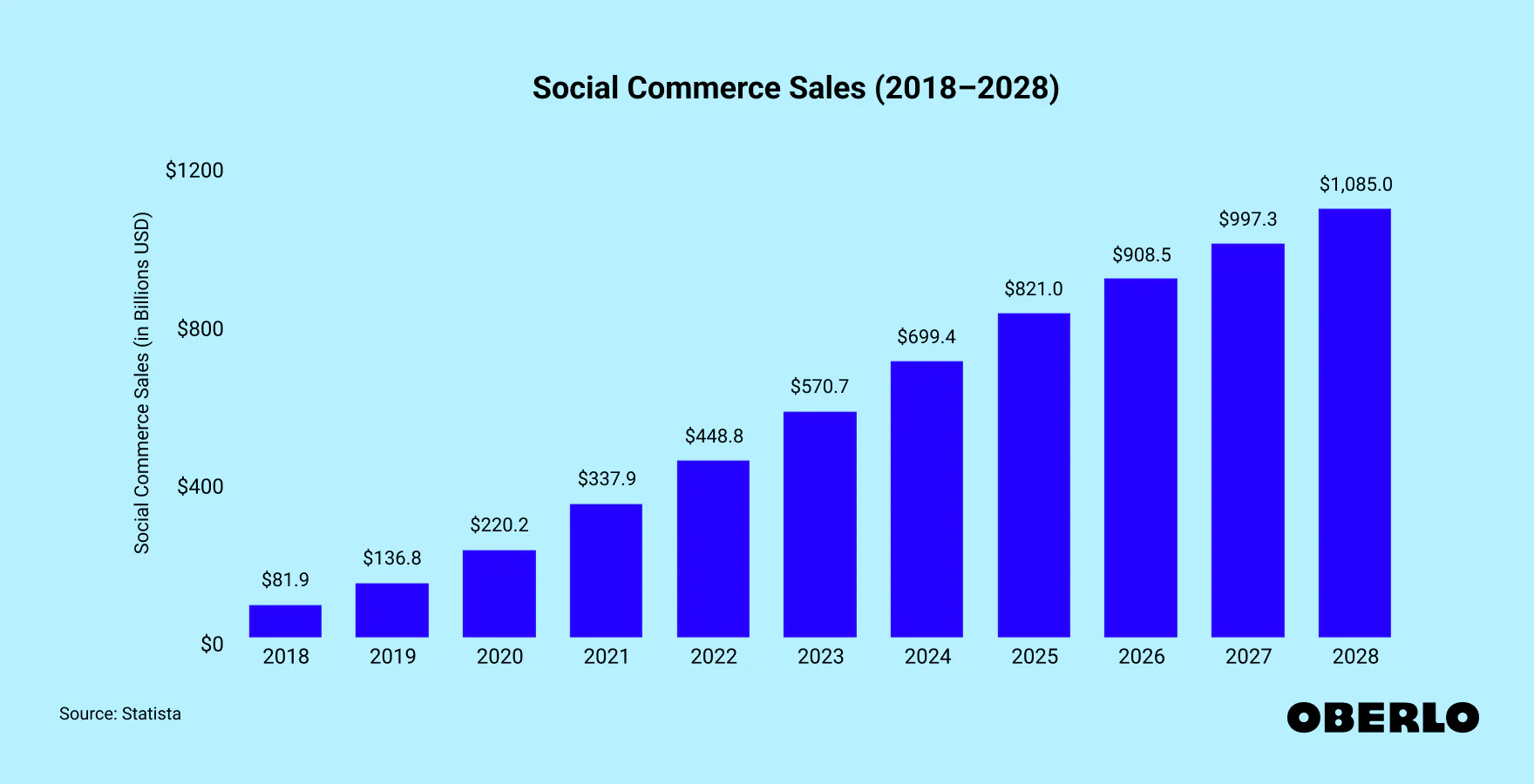
- Increasing Consumer Adoption: A 2023 survey revealed that nearly 60% of U.S. shoppers purchased a product they encountered on social media. This trend highlights the growing influence of social platforms on consumer purchasing decisions.
- Mobile Shopping Dominance: In 2023, 72% of global e-commerce sales were conducted via mobile devices, a figure expected to rise to nearly 88% by 2027. This underscores the importance of mobile-optimized, shoppable content on social platforms.
These statistics highlight the critical role of social media in modern e-commerce, emphasizing the need for brands to integrate shoppable content directly within social platforms to meet evolving consumer behaviors.
How Social Platforms Are Becoming Direct Sales Channels
Facebook, Instagram, TikTok, and Pinterest aren’t just for scrolling. They’re digital storefronts now. Businesses can tag products in posts, run live shopping events, and let users buy in a few taps.
Why does this work? People trust social proof. If they see their friends or favorite creators using a product, they’re more likely to buy. And when the “Add to Cart” button is right there, they don’t think twice.
The Impact of Influencer-Led Shopping Experiences
Influencers drive real-time sales like never before. TikTok Shop, Instagram Live Shopping, and YouTube product drops turn casual viewers into buyers on the spot.
A creator shows off a product, shares a link, and sales start rolling in. No searching. No extra steps. It’s direct, and it works.
Example? A beauty brand partners with a TikTok influencer. They do a 15-second demo, and within minutes, the product sells out. That’s the power of influencer-led shopping.
Best Practices for Creating a Smooth Social Commerce Journey
If you want to sell on social, make it easy. Every extra step loses potential buyers. Here’s how to keep them engaged:
- Use Shoppable Posts: Tag products directly in your photos and videos. No need to leave the app.
- Go Live: Live shopping events build hype and urgency. Add limited-time offers for extra impact.
- Make Checkout Effortless: Platforms like Instagram and TikTok offer in-app purchases. Use them.
- Show, Don’t Just Tell: Short, engaging videos work better than static images. Let people see the product in action.
- Leverage UGC: Feature real customers using your product. It builds trust and increases conversions.
Social commerce isn’t the future—it’s already here. The brands that adapt fast will win big.
8. Interactive & Immersive Marketing
People don’t just want to see ads—they want to engage with them. Static promotions no longer grab attention. Instead, brands that use interactive and immersive experiences keep audiences hooked.
Think AR try-ons, live shopping events, and interactive polls. These approaches make marketing feel less like a sales pitch and more like an experience. When people feel involved, they remember your brand—and are more likely to buy.
The Rise of AR/VR in Digital Marketing
Augmented reality (AR) and virtual reality (VR) aren’t sci-fi anymore. They’re shaping how people shop, learn, and connect with brands.
Try-before-you-buy is a game-changer. Want to see how those sunglasses look on your face? AR filters on Instagram and Snapchat let you test them instantly. Shopping for furniture? IKEA’s app lets you place a virtual couch in your living room before buying.
VR takes it further. Instead of just watching, people can step into a brand’s world. Nike built a VR store where shoppers can browse sneakers in a fully digital space.
This isn’t just fun—it drives sales. If people can try something risk-free, they’re more likely to buy.
Gamification & Interactive Content for Engagement
People love challenges, rewards, and surprises. That’s why gamification works. It turns passive browsing into active participation.
Brands use quizzes, spin-to-win discounts, and interactive polls to keep customers engaged. Sephora’s shade finder quiz helps users pick the perfect foundation, making shopping feel personal and fun.
Then there’s reward-based marketing. Duolingo keeps users hooked with streaks, badges, and points. Starbucks’ app turns loyalty rewards into a game. The more coffee you buy, the more perks you unlock. It works because it’s addictive.
Brands Winning with Immersive Tech
Some brands get it. They don’t just sell products—they build experiences.
- Coca-Cola launched an AR experience where customers could scan cans to unlock exclusive content.
- L’Oréal’s virtual try-on tool lets shoppers test different makeup shades before buying.
- Nike’s SNKRS app used AR to launch exclusive sneakers—fans had to find virtual “stash spots” to unlock purchases.
People crave interaction. The brands that make marketing fun will stay ahead.
9. Data Privacy & Ethical Marketing
People are paying attention to how brands use their data. Ignore this, and you’ll lose their trust fast.
Stricter Regulations & Their Impact on Marketing
Laws like GDPR (Europe) and CCPA (California) aren’t suggestions—they’re forcing businesses to clean up their data practices. No more sneaky tracking or selling customer info without consent. Brands that get caught pay a price, both in fines and reputation.
This means marketers need to adapt. Relying on shady third-party data? That’s dying. The future is first-party data, where people willingly share their info because they trust the brand.
The Shift to Privacy-First Marketing
Brands can’t just ask for data anymore. They have to earn it. That means being clear about what’s collected, why, and how it helps the customer.
Apple’s privacy updates shook the ad world. Facebook’s tracking took a hit. Marketers freaked out. But the reality? Privacy-first strategies work better long-term. When people know they’re in control, they engage more, not less.
Transparency isn’t a trend. It’s what customers expect now.
How Brands Can Build Trust with Ethical Marketing
Honesty matters. If a brand misuses data, people walk. If a brand protects data, people stay. It’s that simple.
Here’s what works:
- Clear opt-ins—No hidden checkboxes. Let people decide.
- Straightforward policies—Nobody reads legal jargon. Keep it human.
- Personalization without creepiness—Use data to help, not to stalk.
Brands that respect privacy will win customer loyalty. The rest? They’ll be left behind.
10. The Sustainability & Purpose-Driven Marketing Movement
People care where their money goes. They don’t just buy products—they buy into values. If a brand ignores this, it shows.
Consumers Want Eco-Conscious & Ethical Brands
Sustainability isn’t a bonus anymore. It’s a requirement. Shoppers read labels, check sourcing, and call out brands that cut corners.
Companies selling cheap, throwaway products? They’re struggling. The ones embracing eco-friendly packaging, ethical labor, and transparency? Thriving.
Consumers want to feel good about their purchases. Brands that get this will earn their loyalty.
How Brands Are Making Sustainability Part of Marketing
The smart ones do more than talk. They prove it.
Nike uses recycled materials in its shoes. Patagonia repairs old gear instead of pushing new. Even fast-food chains are ditching plastic for paper.
People notice these changes. They support brands that align with their values.
Greenwashing—faking sustainability—is risky. Consumers spot the lies and call them out. If a brand claims to be ethical, it better be real.
Authenticity Matters in Purpose-Driven Campaigns
People don’t expect perfection. They expect effort. Brands that admit, “We’re working on it” feel real. The ones that pretend they’ve fixed everything? Not so much.
Being purpose-driven isn’t about big statements. It’s in the details. Ethical sourcing. Fair pay. Less waste. The brands that commit to this stand out—and people remember.
Conclusion
Digital marketing is shifting faster than ever. AI is changing search. Privacy laws are tightening. Consumers expect brands to be transparent, ethical, and engaging. If you’re still relying on outdated strategies, you’re falling behind.
Personalization is now a must, but it has to be done ethically. AI can help, but trust still matters. People want brands that align with their values. That’s why sustainability and purpose-driven marketing aren’t just buzzwords—they’re deal breakers for many buyers.
Social platforms aren’t just for engagement anymore. They’re sales channels. Interactive and immersive content keeps users hooked. Meanwhile, data privacy is no longer optional. Consumers want control, and brands that respect that will earn loyalty.
Bottom line? The brands that stay flexible, experiment, and put their audience first will thrive. The rest will struggle to keep up. Stay ahead, stay relevant, and keep adapting.
Frequently Asked Questions
How is AI changing digital marketing?
AI is transforming everything—SEO, personalization, chatbots, and ad targeting. Google’s AI-driven search (SGE) means businesses must create high-quality, experience-driven content to stay visible. AI also helps brands analyze data and predict trends, making marketing more efficient.
What does the end of third-party cookies mean for marketers?
Without third-party cookies, brands can’t rely on old-school tracking. Instead, first-party data (collected directly from users) is key. Email lists, surveys, and interactive content will help businesses gather customer insights without violating privacy laws.
Why is social commerce growing so fast?
Social platforms like Instagram, TikTok, and Pinterest are turning into shopping hubs. Consumers want seamless buying experiences without leaving their favorite apps. Influencers also play a huge role, driving sales with authentic product recommendations.
How can brands balance personalization and privacy?
The trick is transparency. Brands need to ask for consent, clearly explain how data is used, and offer value in return. AI can still personalize experiences, but it should be done ethically, without feeling invasive.
What’s the biggest mistake businesses make with these trends?
Chasing trends without a strategy. It’s not about using every new tool—it’s about knowing your audience. If a trend doesn’t fit your brand or customers, don’t force it. Focus on long-term trust and engagement over quick wins.







Thanks for sharing such helpful, straightforward tips!